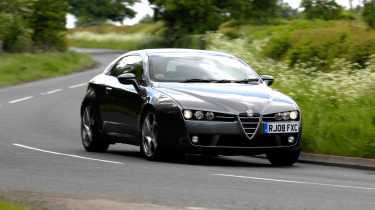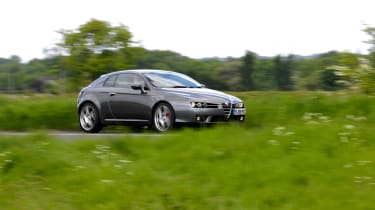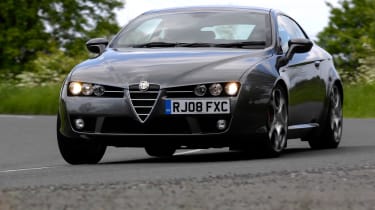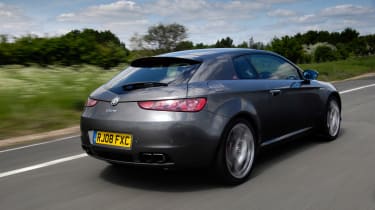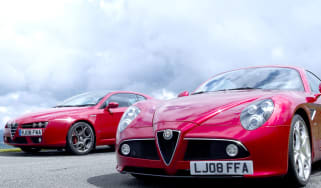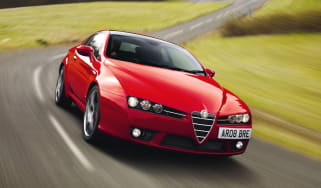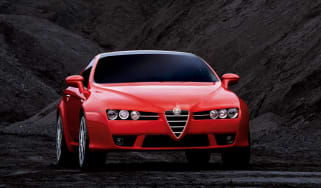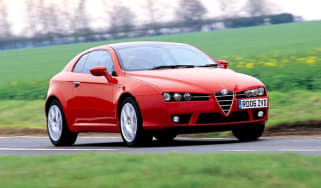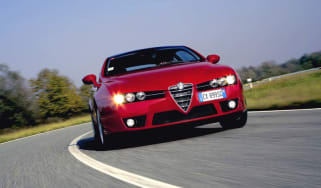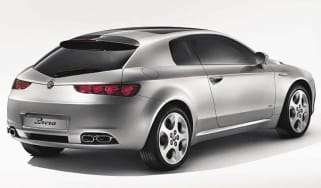Alfa Romeo Brera S (2008-2010) review – UK-only special developed by Prodrive
The unique front-drive V6 Brera developed by Prodrive made for the best-driving Brera, by far…
The Alfa Romeo Brera was born into a time of great promise for the Italian brand. It was on the cusp of a new generation, one it hoped would build on the exciting, passionate, if not exactly sturdy foundations of cars like the 156 and 147 GTAs with a new sense of technology paired to a strong Giugiaro-lead design.
On first appearance, the Brera and its 159 saloon sibling seemed to hit all the right notes – their stunning bodies were stunning to look at, ornate and aggressive, and to hell with traditional proportions.
Yet to drive, this round of Alfas were perhaps even more off the pace, losing their raw edge and replacing with a sort of obstructive and wooden feeling that purveyed every part of their technical make up. When it came to the 159 saloon, it was a shame if not a deal breaker, but in the sporty Brera, it mattered a whole lot more.
The two-plus-two Brera coupe was initially launched (like the 159) with a combination of four-cylinder petrol and diesels, a five-cylinder diesel and 3.2-litre V6 petrol, with either front- or all-wheel drive, but the V6 was all-wheel drive-only, paired to either a six-speed manual or six-speed torque converter auto.
More reviews
The stock Brera 3.2 had natural charm, but was seemingly undecided if it’s a sports car or a luxury GT. Alfa Romeo GB’s marketing director at the time, Nicholas Bernard, held the same view and decided that it should be a sports car. Italy consented to an approach to Prodrive, and the end result was a model unique to the UK, the Brera S. Its key changes were pretty substantial, ditching the four-wheel drive system and returning to front-drive, a configuration previously unavailable. Alfa didn’t see the need to fit a limited-slip differential, but the fact that the S coped easily with 256bhp coursing through its front wheels was testimony to the quality of the development work carried out by Prodrive.
Mind, you’d perhaps expect nothing less; Alfa GB spent £1m creating a Brera more relevant to UK drivers and UK roads. The project took a year, and included full durability testing and final sign-off by Alfa in Italy. Just 500 examples were built, and the cost? It was only around £1450 more than the stock versions, at which level Alfa GB only just merely broke even.
If you’ve wavered over a Brera in the past, you’ll fall instantly in love with the S on its bespoke 19in rims. It’s much closer to how the car looked in the concept sketches; sitting low on out-size rims. It instantly renders the standard car frumpy, though some reckon it’s always looked like that. I reckon if Alfa offered the rims and slightly lowered suspension for £1450 on stock models, uptake would have been near 100 per cent, but that didn’t happen.
The Brera S was also offered with the 182bhp 2.2-litre four, which gave a £3500 saving over the 3.2’s £28,450 list price, but we can’t recommend it. It’s never been a firecracker of an engine, and the handling with the S chassis is now so good that it feels gutless.
The V6 is the one. Ditching the four-wheel drive gubbins and adding those lovely rims (worth a 2kg saving per corner over the stock 17s) contributes to a weight saving of almost 100kg compared to the standard V6 Brera, so the performance is notably crisper. All post-2008 Breras featured hollow anti-roll bars and aluminium uprights, which also saved weight. Prodrive also added Eibach springs which are 50 per cent stiffer, and bespoke Bilstein dampers.
Certainly there’s an edge to the ride, but it’s a well-judged firmness beneath which is compliance and suppleness, so it’s not a car that gets crashy and harsh when the surface goes to pot. Better than this is the mechanical grip and traction created by the new setup. The mass of the V6 engine is kept well in check, allowing the tyres to get on with the business of getting the torque and power to the road. Point the Brera into a turn and the initial roll motion is tightly controlled, giving a feeling of clean and direct response through the steering wheel, and it stays on line and hooked up when you stoke up the engine and aim at the apex.
Switch traction control off, get really aggressive with the throttle and in the dry you might just succeed in breaking traction of an inside wheel. Indeed, traction is so good you can’t imagine needing the four-wheel drive of the standard model at all, even in the wet.
At a little over 1500kg it’s still no lightweight, but cross country the Brera feels confidently all-of-a-piece and much more precise and finely adjustable than the stock V6. There’s plenty of grip from the 235/40 P Zero Neros, and at a brisk road pace it feels poised and neutral. The wheel might not brim with feel but the steering is well-weighted and quick enough, while the manual shift is pleasingly mechanical, giving a decent feeling of connection.
The best bits of the original 3.2 – the engine and the interior – are only enhanced. The V6’s delivery and creamy, characterful score are now a fraction more insistent thanks to the weight savings and exhaust tweaks. Inside, the facia and attractive, pleated leather seats feature red stitching, and there are unique instrument markings.
The Brera S is no Porsche Cayman S, but it shouldn’t be mistaken for a stock Brera wearing glamorous wheels either – it’s far better than that. Prodrive’s chassis work released its inner sports car, while weight savings gave the performance more sparkle. If you’ve got an itch to have a Brera, trust us: the best way to scratch it is the V6-engined S.
Prices and rivals
The Brera S is one of those cars on the used market that has a small, but very intense fan club, so like a fair few high performance Alfa Romeos, can vary massively in price. Being a late model, and relatively restricted in number (especially the V6), a clean, low mileage V6 can cost anywhere from £16,000 to £18,000, but once the mileage, or condition, tips it beyond the enthusiast buyer, prices drop right down to below £10,000. This is still significantly more than earlier Brera models, but as the S was built in relatively high numbers, it’s generally the more common Brera if you’re looking specifically for a V6.
These prices also put it well above the price points of some rivals like the 3.2-litre V6 FSI Audi TT of the same era. The second generation TT doesn’t quite have the iconic style of the original, nor the more agile chassis of the current third generation, but the V6 model was available for a time with a six-speed manual transmission, and in comparison to the Brera drives perfectly well. Porsche’s 987 Cayman S has really clung onto its value, so don’t expect much choice around the Brera S’s low price points.
Specifications
| Engine | V6 |
| Location | Front, transverse |
| Displacement | 3195cc |
| Bore x stroke | 89 x 85.6mm |
| Cylinder block | Aluminium alloy |
| Cylinder head | Aluminium alloy, DOHC per bank, 4v per cylinder, variable valve timing |
| Fuel and ignition | Electronic engine management, sequential multipoint injection |
| Max power | 256bhp @ 6300rpm |
| Max torque | 237lb ft @ 4500rpm |
| Transmission | Six-speed manual gearbox, front-wheel drive, ASR stability and traction control system |
| Front suspension | Double wishbones, coil springs, gas dampers, anti-roll bar |
| Rear suspension | Multi-link, coil springs, gas dampers |
| Steering | Rack and pinion, power assisted |
| Brakes | Vented discs, 330mm front, 292mm rear, ABS, EBD |
| Wheels | 19in front and rear, aluminium alloy |
| Tyres | 235/40 ZR19 front and rear, Pirelli P Zero Nero |
| Weight (kerb) | 1532kg |
| Power-to-weight | 170bhp/ton |
| 0-62mph | 7.0sec (claimed) |
| Top speed | 155mph (claimed) |
| Basic price | £28,450 |
| On sale | 2008 |
| evo rating | 4/5 |

